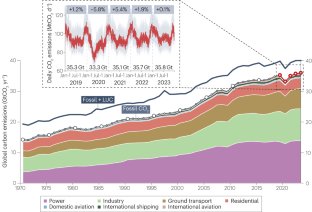Global CO2 emissions for 2023 increased by only 0.1% relative to 2022 (following increases of 5.4% and 1.9% in 2021 and 2022, respectively), reaching 35.8 Gt CO2. These 2023 emissions consumed 10–66.7% of the remaining carbon budget to limit warming to 1.5°C, suggesting permissible emissions could be depleted within 0.5–6 years (67% likelihood).
Key points
-
Data from the Carbon Monitor indicate 35.8 Gt CO2 were emitted globally in 2023.
-
Although the trend is upwards, the pace of growth has been slowing, suggesting global emissions might have plateaued.
-
India overtook the EU as the third highest emitter globally.
This is a preview of subscription content, access via your institution
Access options
Access Nature and 54 other Nature Portfolio journals
Get Nature+, our best-value online-access subscription
$29.99 / 30 days
cancel any time
Subscribe to this journal
Receive 12 digital issues and online access to articles
$99.00 per year
only $8.25 per issue
Buy this article
- Purchase on Springer Link
- Instant access to full article PDF
Prices may be subject to local taxes which are calculated during checkout

References
Liu, Z. et al. Global patterns of daily CO2 emissions reductions in the first year of COVID-19. Nat. Geosci. 15, 615–620 (2022).
Liu, Z., Deng, Z., Davis, S. J., Giron, C. & Ciais, P. Monitoring global carbon emissions in 2021. Nat. Rev. Earth Environ. 3, 217–219 (2022).
Liu, Z., Deng, Z., Davis, S. & Ciais, P. Monitoring global carbon emissions in 2022. Nat. Rev. Earth Environ. 4, 205–206 (2023).
Friedlingstein, P. et al. Global Carbon Budget 2023. Earth Syst. Sci. Data 15, 5301–5369 (2023).
IEA. World Energy Outlook 2023 (IEA, 2023); https://www.iea.org/reports/world-energy-outlook-2023.
IPCC. Climate Change 2021: The Physical Science Basis. Contribution of Working Group I to the Sixth Assessment Report of the Intergovernmental Panel on Climate Change (Cambridge Univ. Press, 2021).
Lamboll, R. D. et al. Assessing the size and uncertainty of remaining carbon budgets. Nat. Clim. Change. 13, 1360–1367 (2023).
Crippa, M. et al. Fossil CO2 and GHG Emissions of All World Countries - 2020 report. (Publications Office of the European Union, 2020).
Zhu, B. et al. CarbonMonitor-Power near-real-time monitoring of global power generation on hourly to daily scales. Sci. Data 10, 217 (2023).
Ke, P. et al. Carbon Monitor Europe near-real-time daily CO2 emissions for 27 EU countries and the United Kingdom. Sci. Data 10, 374 (2023).
Author information
Authors and Affiliations
Corresponding author
Ethics declarations
Competing interests
The authors declare no competing interests.
Rights and permissions
About this article
Cite this article
Liu, Z., Deng, Z., Davis, S.J. et al. Global carbon emissions in 2023. Nat Rev Earth Environ 5, 253–254 (2024). https://doi.org/10.1038/s43017-024-00532-2
Published:
Issue Date:
DOI: https://doi.org/10.1038/s43017-024-00532-2
This article is cited by
-
Climate policy in 2023
Nature Reviews Earth & Environment (2024)
